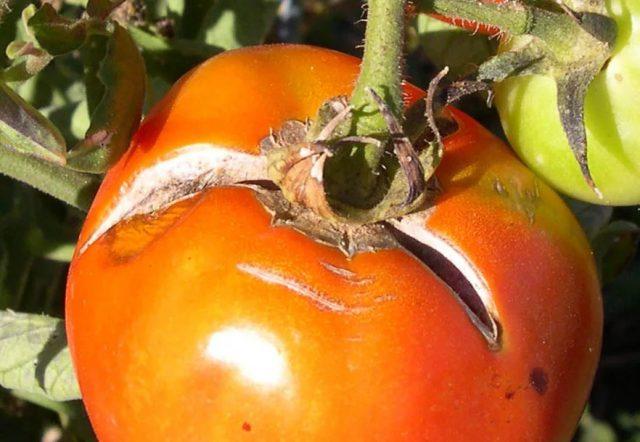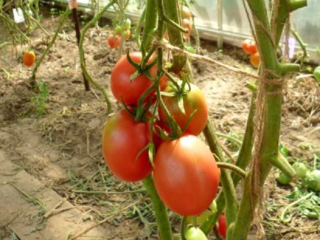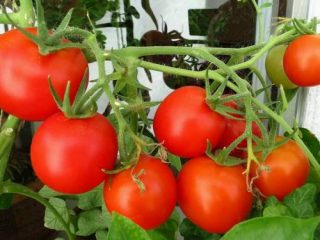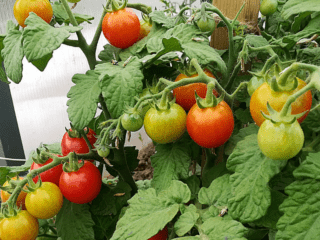Content
If tomatoes crack during ripening, the problem is usually caused by unfavorable weather conditions or violations in agricultural practices. In some cases, the crop can be saved.
Why are cracks on tomatoes dangerous?
If tomatoes crack during ripening, not only the appearance of the fruit suffers. Through damage, fungi and microorganisms penetrate inside the tomatoes, the vegetables begin to rot, losing their beneficial properties and taste.
If the cracks on the fruits are small, the tomatoes can be sent for storage. But their shelf life is greatly reduced; after just a few days, the vegetables become unfit for consumption.
Types of cracking of tomato fruits
There are quite a few reasons for cracking tomatoes. It helps to determine why the fruits have lost their integrity, including the pattern of damage.
Radial
With radial cracking in tomatoes, the damage rays radiate away from the stalk. They usually appear against the backdrop of a long drought with rare but excessively abundant watering. Also, radial cracking is provoked by temperature changes between day and night.

If the tomatoes begin to crack radially, the problem may be a lack of boron in the soil.
Concentric
In some cases, tomatoes crack into small strips that form near the stalk and spread out in all directions in circles and semicircles. Damage occurs when there is excess nitrogen in the soil. The tomato begins to absorb potassium and calcium worse, resulting in it bursting.

Excessive watering can lead to the appearance of concentric cracks.
Mesh
In accordance with the name, with this type of cracking, a thin light mesh appears in the upper part of the tomato. It is formed due to the separation of the pericarb located directly under the peel. It usually occurs in the early stages of tomato ripening; it can be distinguished even on green fruits.

Reticular cracking appears if a sharp cold snap occurs at the time of ovary formation
Mesh cracks heal quickly and pose the least danger to the crop. Their appearance often occurs against the background of damage to flowers, excess nitrogen or calcium in the soil and potassium deficiency. Large-fruited tomatoes crack more often than others.
Why do tomatoes burst on branches in open ground?
Tomatoes crack outside usually due to bad weather or improper care. Several factors lead to damage.
Temperature difference
In hot and dry weather, tomatoes in open ground can get sunburned.Under direct rays, the skin becomes very hot and becomes rough. The fruits increase in size as they ripen, but the shell loses its ability to stretch. Over time, it cannot withstand internal pressure and bursts.
If the tomatoes have already begun to crack, it is very difficult to do anything about it. To prevent the problem, it is recommended to plant bushes not in the sun, but in a slightly shaded place. It is advisable that the tomatoes continue to receive light in the afternoon, but not under direct rays.
Overwatering
If the tomatoes begin to crack, the reason may be due to abundant and irregular watering. Bushes should receive moisture almost constantly, but in limited quantities.
If the soil dries out for a long time, the ripening fruits stop growing and their skin begins to become rough. Then, when receiving a large amount of moisture, the tomatoes begin to grow sharply. The shell, which has lost its elasticity, bursts from internal pressure.
Exposure to heat
If red tomatoes are bursting, too much heat may be causing the problem. Tomatoes develop best at 26-28 °C in conditions of moderate humidity.
If hot weather persists outdoors for a long time, ripening fruits may dry out. The tomato shell becomes rough and dense, at a certain stage it bursts due to the increase in size of the tomatoes.
You can avoid damage in extreme heat by spraying frequently. Tomato bushes are irrigated with settled, lukewarm water every evening after sunset.
Incorrect stepsoning
Most varieties of tomatoes require obligatory pinching. However, it must be carried out in accordance with the rules. You cannot remove all the side shoots of tomatoes - this will lead to the fruits starting to crack.
Tomato roots extract water from the soil in accordance with the volume of green mass. If you cut off all the stepsons in one day, the plant will not be able to quickly rebuild and reduce its moisture consumption. Excess liquid will flow into the fruits, and the tomatoes will begin to crack due to too rapid growth.
Tomatoes must be shaped carefully when growing. Stepchildren are removed gradually so that the bushes can regulate metabolic processes and the volume of moisture evaporation.
Pinching during ripening
Another common reason why tomatoes crack on the bushes is untimely pinching. It is necessary to shorten the main stem in the early stages of crop development.
If pinched shortly before harvest, the tomato will not be able to evaporate excess moisture through the greens and will direct the water into the fruit. Even the elastic skin of tomatoes will begin to crack, as the pressure on it will increase sharply.
Errors when feeding
An objective assessment of the quality of feeding allows you to understand why red tomatoes crack. Damage to fruits occurs when there is an excess of nitrogen in the soil, as well as when applying excessively concentrated complex fertilizers. Ripening tomatoes receive more nutrients than necessary, and their skin begins to crack.
Tomatoes must be fertilized in strict accordance with the instructions for specific preparations. Typically, weak nutrient solutions are used; only 20-40 g of potassium and phosphorus are mixed in a bucket of water.At the stage of fruit ripening, nitrogen is not added at all or added in minimal quantities.

Immediately before harvesting, fertilizing tomatoes can be completely canceled so that the fruits do not begin to crack.
Diseases
At any stage of the growing season, tomatoes can begin to crack under the influence of fungal and bacterial diseases. Typically characteristic damage appears:
- with late blight;
- with apical and gray rot;
- with Alternaria;
- for bacterial spotting.
In case of diseases, cracks in tomato fruits are usually accompanied by the appearance of spots on the leaves and stems. The bushes generally look unhealthy, turn yellow and brown, and quickly wither. Tomatoes not only begin to crack, but also rot, dark soft spots and mold deposits form on their surface.
The development of fungi is promoted by factors such as waterlogging of the soil, excess nitrogen in the soil and insufficient ventilation of the bushes. To deal with a problem, you need to eliminate its cause. All affected fruits and green parts of tomatoes are destroyed, the remaining plantings are treated with fungicides - Fitosporin preparations, Bordeaux mixture and copper sulfate. After treatment, the approach to growing bushes is reviewed and agricultural practices are adjusted.
Overripening of fruits
At the harvest stage, tomatoes may begin to crack due to normal over-ripening. If the fruit is left on the shoots longer than necessary, the skin will burst due to pressure from the pulp. At the same time, the tomatoes soften and rot, become tasteless and emit an unpleasant aroma.

Harvesting is recommended immediately after the fruits turn red.
Features of the variety
Some tomatoes may crack more often than others due to genetic characteristics. In particular, the following are susceptible to damage:
- early ripening hybrids with especially thin skin;
- large-fruited varieties with fast growth;
- yellow and pink tomatoes.
When growing such varieties, it is necessary to especially carefully observe agricultural techniques and prevent overripening.
Why do tomatoes crack in a greenhouse?
If tomatoes burst in a greenhouse, this can be caused by the same reasons as in open ground. The damage to the integrity of the fruit is primarily caused by waterlogging of the soil. In a greenhouse, moisture evaporates from the ground more slowly than in the open air, so the intensity of watering must be carefully controlled.
Tomatoes can crack due to insufficient ventilation - this factor contributes to waterlogging of the soil and the occurrence of fungal diseases. Frequent spraying of bushes poses a great danger. Tomatoes in a greenhouse crack when the air humidity is high, because the fruits grow too actively and the skin does not have time to stretch under the pressure of the pulp.
Why do green tomatoes burst on the bush?
In open ground and in greenhouses, tomatoes usually burst in the later stages of ripening. But green tomatoes that have just begun to develop can also crack. This usually happens for several reasons:
- due to a sharp change in weather conditions - against the backdrop of cold weather, the shell of tomatoes becomes harder and bursts immediately after the pulp begins to grow;
- due to a predisposition to cracking - very often yellow varieties of tomatoes are damaged in the early stages;
- due to incorrect pinching - when pruning a large number of shoots, young fruits may burst due to excess moisture.
Cracks on green tomatoes heal easily in many cases. But if damage occurs, it is necessary to provide the bushes with especially careful care so that the problem does not worsen.
Preventing tomatoes from cracking
If tomatoes crack in a greenhouse or soil, it is not always possible to save the damaged fruits. It is recommended to focus on prevention. In particular, it is necessary:
- choose varieties for planting that do not have a predisposition to cracking;
- water the tomatoes often, but in moderation, to avoid drying out and waterlogging of the soil;
- regularly inspect the bushes and carry out therapeutic spraying at the first symptoms of fungi;
- be careful when pinching and pinching - do not remove too much green mass in one procedure;
- Apply fertilizing in low concentration and no more than twice a month.
When growing tomatoes, it is also necessary to monitor temperature conditions and air humidity. In the greenhouse, the bushes need to be ventilated daily for 20-30 minutes in the evening.
Tomatoes that are resistant to cracking
There are varieties of tomatoes that do not crack in a greenhouse or in the ground if basic care rules are followed. Popular varieties include the following:
- Grushovka. The mid-ripening variety bears oval fruits weighing up to 120 g. It withstands adverse weather well and rarely begins to crack.
Grushovka tomatoes are stored for a long time and are suitable for growing for sale
- Centaur. The hybrid tomato variety is characterized by high yield. It is not prone to cracking and does not suffer from fungal diseases. The fruits of this variety are round, large, with a slightly ribbed surface. Tomatoes have excellent taste.
The weight of tomatoes of the Centaur variety is on average 150 g
- Favorite. An early-ripening variety produces medium-sized tomatoes up to 120 g. It has high endurance and does not begin to crack even with frequent changes in temperature and humidity.
The Favorit variety allows you to harvest up to 7 kg of crop from one bush
Even when growing hardy varieties, basic rules of agricultural technology must be followed. If you take care of the bushes carelessly, any tomatoes will begin to crack.
Conclusion
If tomatoes crack in the early or late stages of ripening, the problem is usually that the skin of the fruit does not have time to stretch properly. The reason may be improper watering and fertilizing, as well as fungal diseases.











